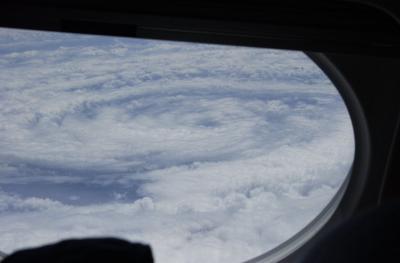Ocean Salinity Strongly Influences Rapid Intensification of Tropical Cyclones
Rapid intensification is defined as an event where the intensity of a tropical cyclone increases by 30 knots or higher in a 24-hour period. Predicting it is currently one of the greatest challenges that operational hurricane forecasters face. Tropical cyclones intensify by extracting heat energy from the ocean surface. Previous research has shown that along with pre-storm sea surface temperature, the heat content of the upper-ocean or the depth of the warm water reservoir also play an important role in rapid intensification. Consequently, sea surface temperature and upper-ocean heat content are the only ocean-related parameters used in statistical rapid intensification prediction schemes. While past research has shown that low-salinity water at the ocean surface may play an important role in tropical cyclone intensification through its effect on tropical cyclone-induced vertical mixing and sea surface temperature cooling, its specific role in rapid intensification has not been evaluated. Using a suite of observations and numerical model simulations, a team of scientists, including staff at the U.S. Department of Energy’s Pacific Northwest National Laboratory, showed that salinity has a significant impact on rapid intensification in the western tropical Atlantic Ocean.
Although only about 10% of tropical cyclones experience rapid intensification, the socio-economic impacts of this phenomenon are disproportionately high recognizing that all Category 4 and 5 hurricanes in the Atlantic Ocean undergo rapid intensification at some point during their lifetimes. During the 2017 Atlantic hurricane season, several devastating hurricanes underwent rapid intensification before landfall, such as Hurricanes Harvey, Irma, and Maria. In 2018, Hurricanes Florence and Michael underwent explosive rapid intensification before making landfall over the Carolinas and the Florida panhandle, respectively. More recently, Hurricane Dorian underwent rapid intensification in August 2019 before scything through the Bahamas. Also, the phenomenon of rapid intensification has an important effect on hurricane climatology. With most numerical models currently unable to simulate hurricane rapid intensification, identifying key factors contributing to predictability of rapid intensification is critical to improving prediction of rapid intensification for emergency preparedness.
First, the team analyzed pre-storm sea surface temperatures, tropical cyclone-induced sea surface temperature cooling, and air-sea enthalpy fluxes. They noticed that the role of the ocean in tropical cyclone intensification increases with the rate of intensification. That means, the ocean may not play a significant role for weakly intensifying tropical cyclones. However, for hurricanes intensifying rapidly, the subsurface ocean does play a critical role. This is because the intensity of tropical cyclones undergoing rapid intensification is generally higher and the vertical mixing extends considerably deeper, allowing ocean stratification effects to play a role.
Next, the researchers showed that the western tropical Atlantic can be broadly separated into two regions based on the relative significance of temperature and salinity for ocean density stratification: (1) A western subregion that includes the western Caribbean Sea and the Gulf of Mexico where the ocean thermal structure dominates ocean stratification, and (2) An eastern subregion that includes the Amazon-Orinoco River plume region and the eastern Caribbean Sea where salinity primarily determines upper-ocean density. The researchers analyzed ocean stratification, sea surface salinity, and tropical cyclone heat potential and found that the subsurface ocean does not play an important role for weakly intensifying hurricanes in either region. However for rapid intensification, the ocean thermal and salinity stratification play an important role in the western and eastern subregions, respectively.
The researchers confirmed these results using a suite of numerical experiments performed with an ocean mixed layer model. They initialized the Price-Weller-Pinkel mixed layer model with vertical ocean temperature and salinity profiles from Argo floats and subjected it to tropical cyclone forcing representing various rates of intensification. Then the researchers performed simulations with and without salinity. The simulations revealed that the salinity effect on tropical cyclone-induced mixing and sea surface temperature cooling becomes prominent as the rate of tropical cyclone intensification gets higher, supporting the observational results. Finally, using the statistical binary classification technique of logistic regression, the team showed that including salinity improves the model’s ability to detect the chance of rapid intensification occurring. In light of this study, the availability of surface salinity measurements at a global scale and in near real time from satellites offers promise for improvement in operational rapid intensification forecasts.

